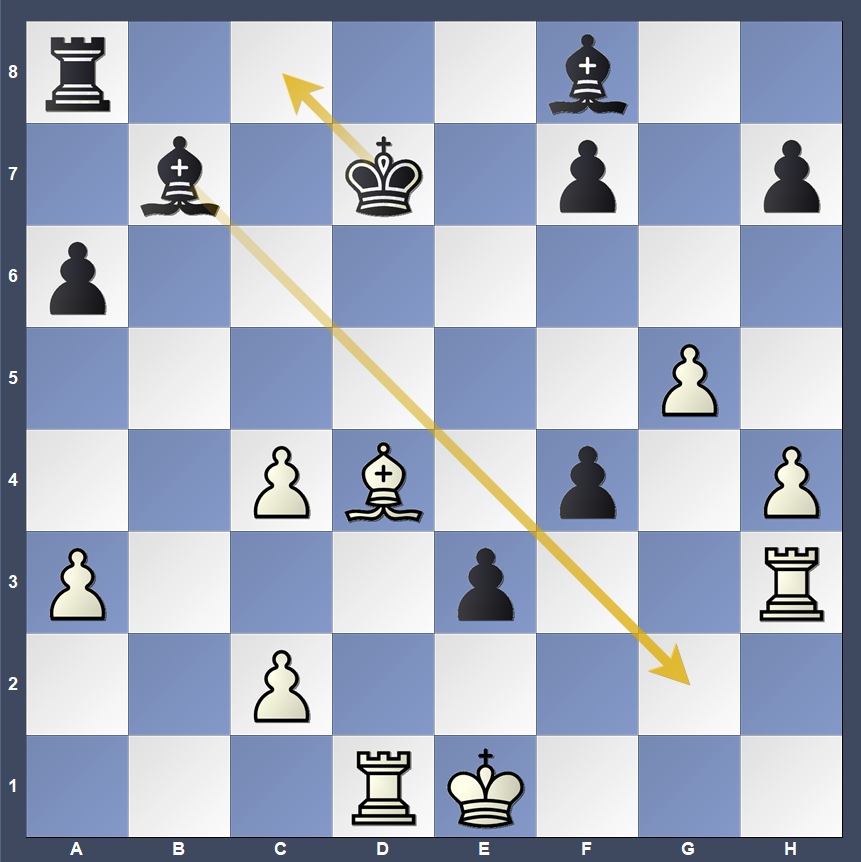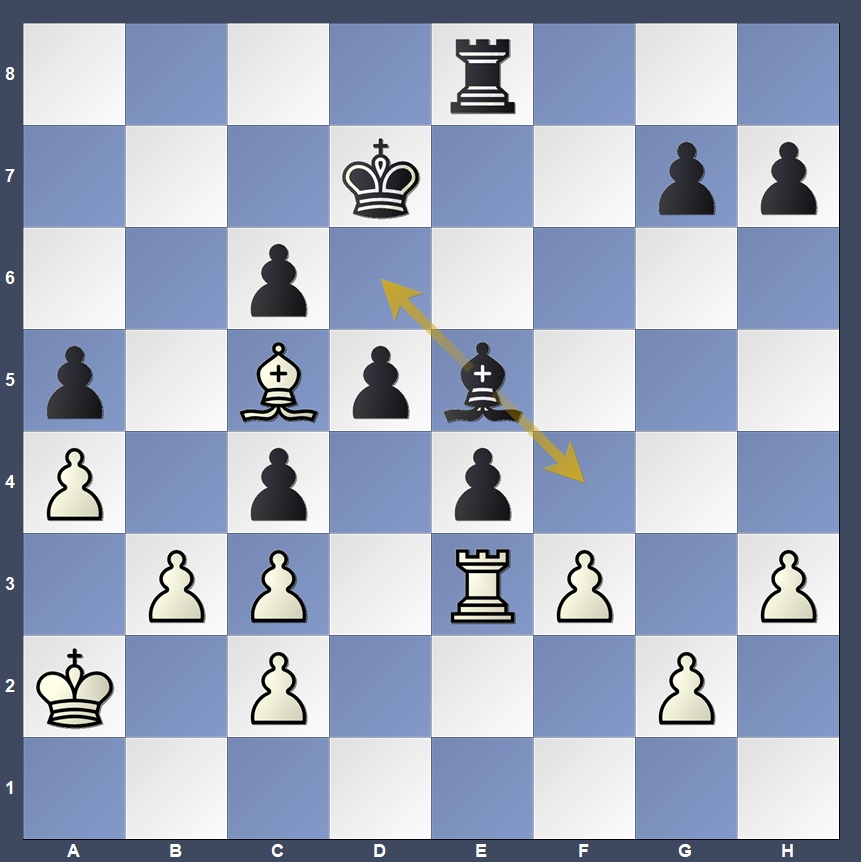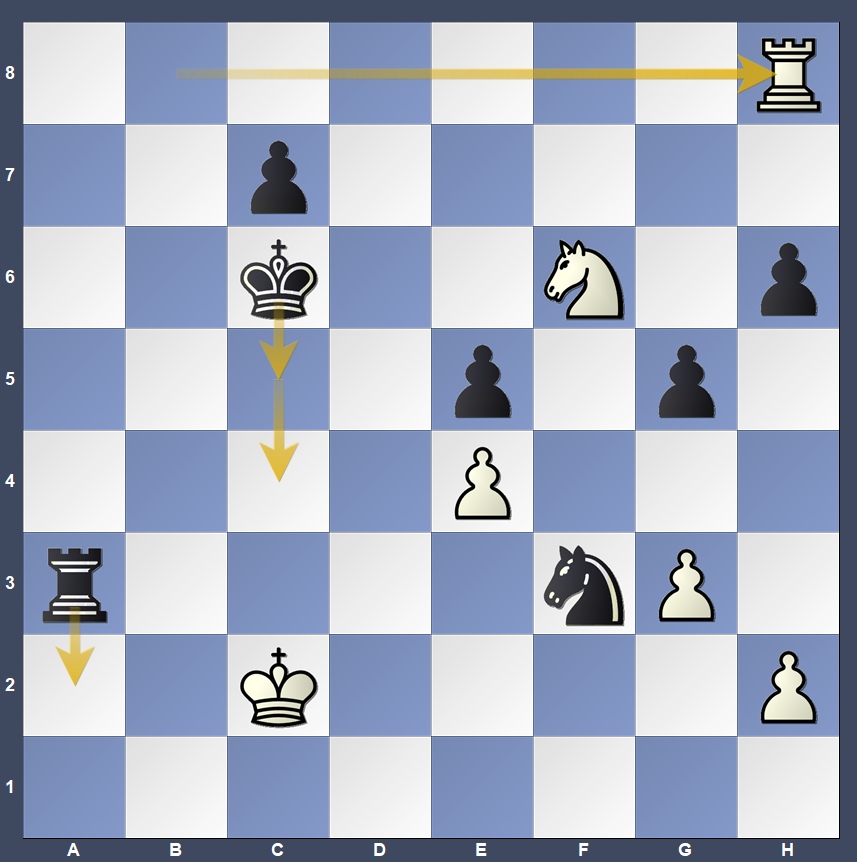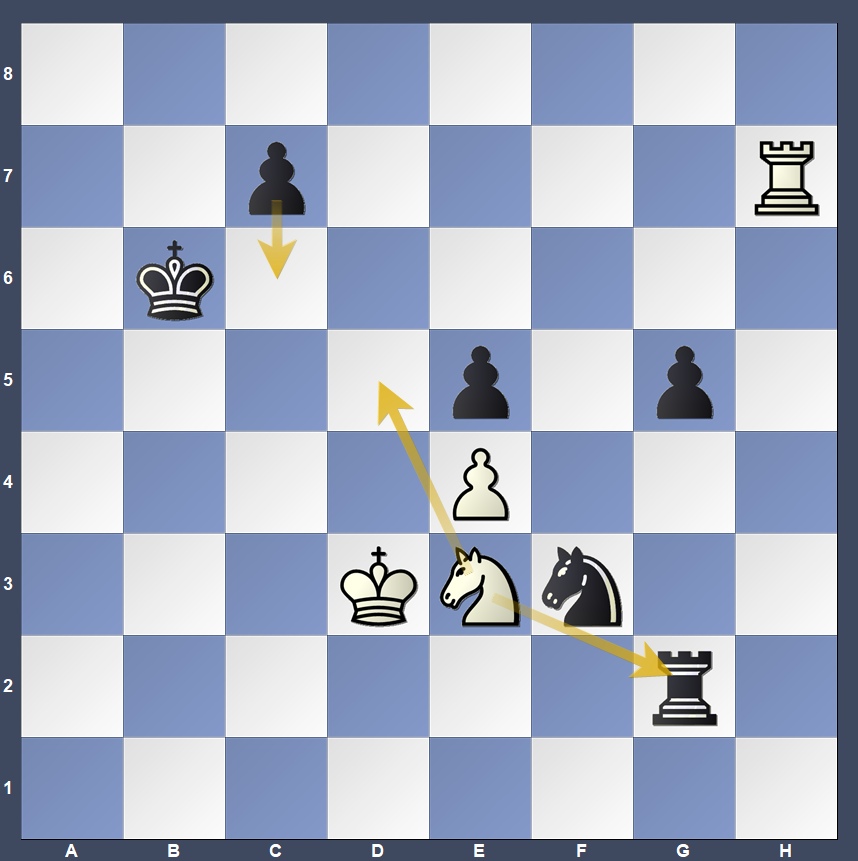
It was the quickest day at the FIDE World Cup so far, with both semifinal tiebreak matches ending in the first 15+10 rapid portion. The day concluded by 16:45, but the speed did not diminish the drama. In the match between Javokhir Sindarov and Nodirbek Yakubboev, Sindarov’s preparation paid off as he took the first rapid game converting a winning endgame. The second game was more tense, with Yakubboev finding real chances to strike back, but the players eventually drew, sending Sindarov through as the first player to reach the finals as well as the 2026 FIDE Candidates.
On the opposite side of the stage, the match between Andrey Esipenko and Wei Yi was a rollercoaster from beginning to end. Wei Yi, considered the favourite, obtained winning chances as Black in the first game but ultimately drew. In the second rapid game, it was Esipenko who held the advantage until a fateful rook blunder reversed the outcome and cost him the match. It was a shocking end to the semifinal tiebreaks.
The ceremonial first move was made by Mr. Sadanand Shet Tanavade, Member of Parliament (Rajya Sabha), on the board between Sindarov and Yakubboev. Throughout the event, it has been encouraging to see the interest shown by government officials and the AICF’s efforts to invite distinguished guests to each game.
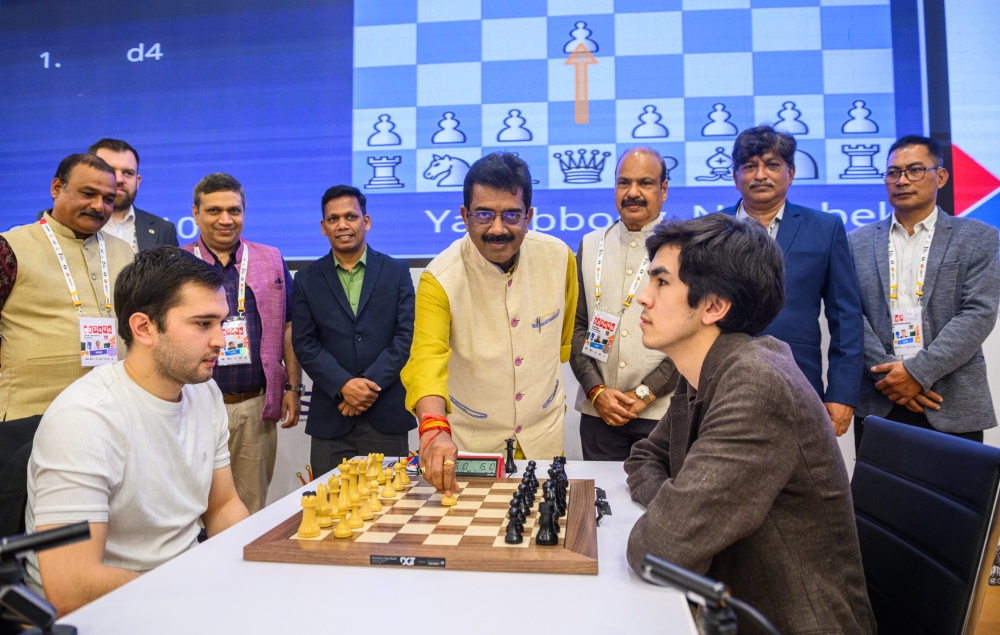
At 15:00, the silence of the hall shifted to the quick tapping of clocks. Unlike the classical games, all players seemed settled from the very first moves, confidently blitzing out their opening choices. Here is a closer look at how the games unfolded:
Semifinals tiebreak results:
Andrey Esipenko ½–1½ Wei Yi
Javokhir Sindarov 1½–½ Nodirbek Yakubboev
Javokhir Sindarov (2721) vs Nodirbek Yakubboev (2689)
Javokhir Sindarov is only a few rating points away from becoming the top player in Uzbekistan. As The Guardian recently described, he is “on the verge” of the world elite, and he demonstrated that level today by starting the semifinal tiebreaks with a win over Nodirbek Yakubboev with the Black pieces.
The first game began in a typical Semi-Slav structure, following a sideline known for its solidity. Both players appeared well prepared, but they soon diverged from known theory. Up to that point they had played accurately, but White, already behind on time throughout the game, made several imprecise decisions that allowed Black to take over. In a closed position with both sides holding two rooks, White with a bishop, and Black with a knight, Sindarov used the flexibility of his knight to maneuver it into strong squares on the queenside. This eventually forced the bishop-knight exchange, leaving Black with a superior pawn structure.

In the resulting position, Black controlled the board with active rooks pressing against White’s isolated e-pawn. With less than a minute remaining, Yakubboev was forced to defend resourcefully. Sindarov did not find an immediate finishing blow, but he eventually secured two connected passed pawns on the queenside. With no realistic defensive chances left, Yakubboev resigned, placing himself in a must-win situation with Black in the second rapid game.
Their second 15+10 game began in a Sicilian Najdorf and quickly turned chaotic after White launched an early kingside pawn storm. A key psychological moment came when Sindarov spent nine minutes on 12.f4. Our studio commentators, Grandmasters Peter Leko and Jan Gustafsson, pointed out that this may have caused Yakubboev to relax slightly and choose the wrong plan. White gained an advantage, and Black soon had to give up the exchange, relying on the bishop pair to create counterplay. As is often the case in this time control, chances swung back and forth. Sindarov lost his advantage for a moment, and suddenly Black stood better with real hope of staying in the event. But a major mistake changed the evaluation again. Although White did not convert perfectly and allowed equality more than once, he eventually steered the game into a draw.
Here, Black should ignore the potential discovered check on the d-file and play something like 26…Bg2, followed by 27.Bxe3+ Kc6 28.Rh2 Bf3. The position remains equal but requires accuracy from White.
Instead, Yakubboev played 26…Kc8?, moving the king away from danger but shutting off his rook and giving White a +3 advantage. Sindarov was not fully precise in converting, exchanging winning chances for equality several times, but a final liquidation to a draw was enough to secure his place in the finals and the 2026 FIDE Candidates.
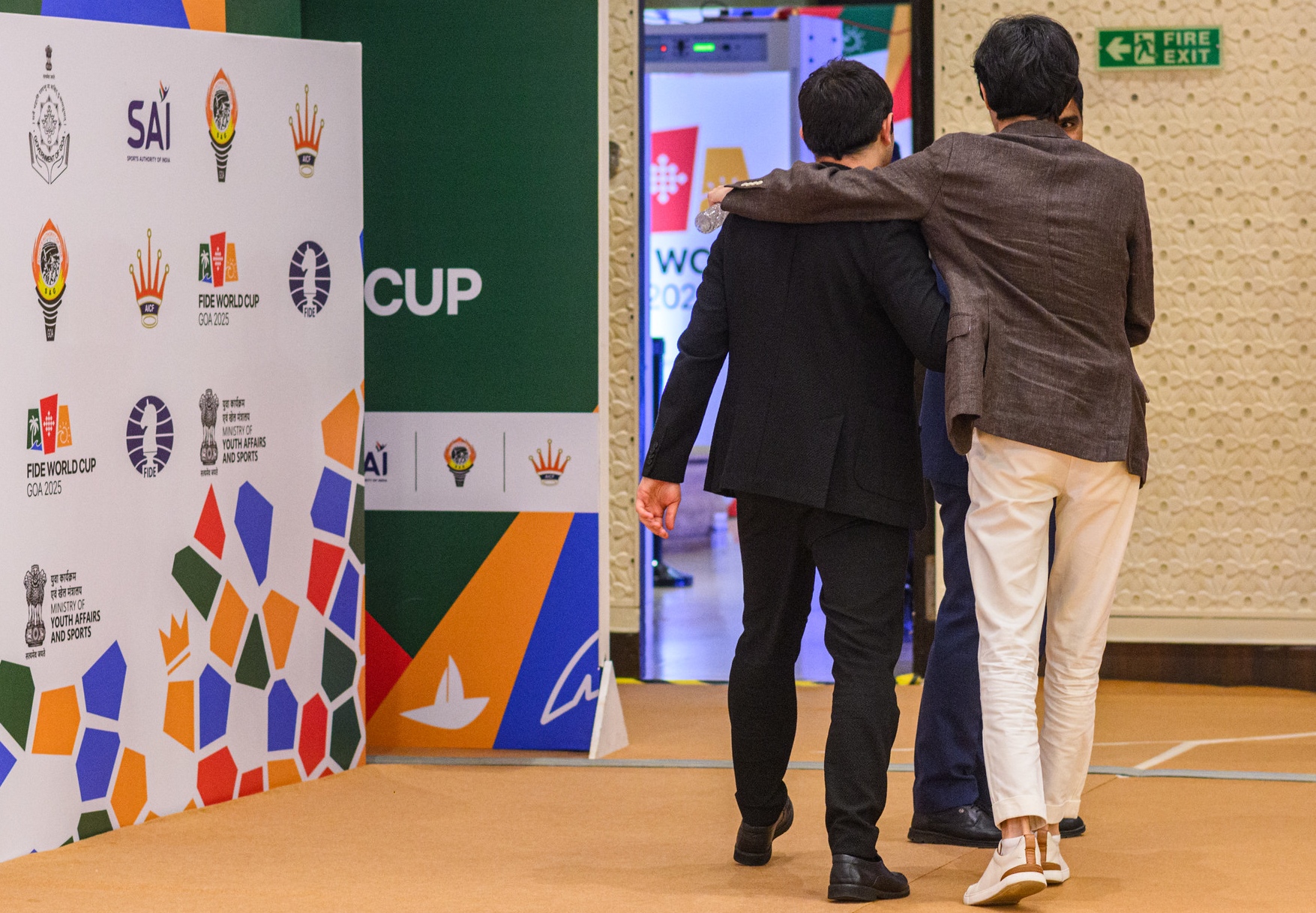
Sindarov was delighted after the match, though he expressed sadness for his teammate, noting that Yakubboev had played well. In our interview, he spoke proudly about his performance today and shared that his family, including his brother, had traveled to Goa to support him, bringing Uzbek food and sweets to lift his spirits. It seems to be working.
Andrey Esipenko (2693) vs Wei Yi (2752)
Wei Yi looked markedly different after winning the tiebreak against Andrey Esipenko today, especially given the stroke of luck that helped him not just survive the second game but win it. First, let’s revisit the opening rapid game, where the Chinese grandmaster once again started strongly, echoing his match against Arjun Erigaisi, where he recovered from a difficult classical phase with much stronger play in the tiebreaks.
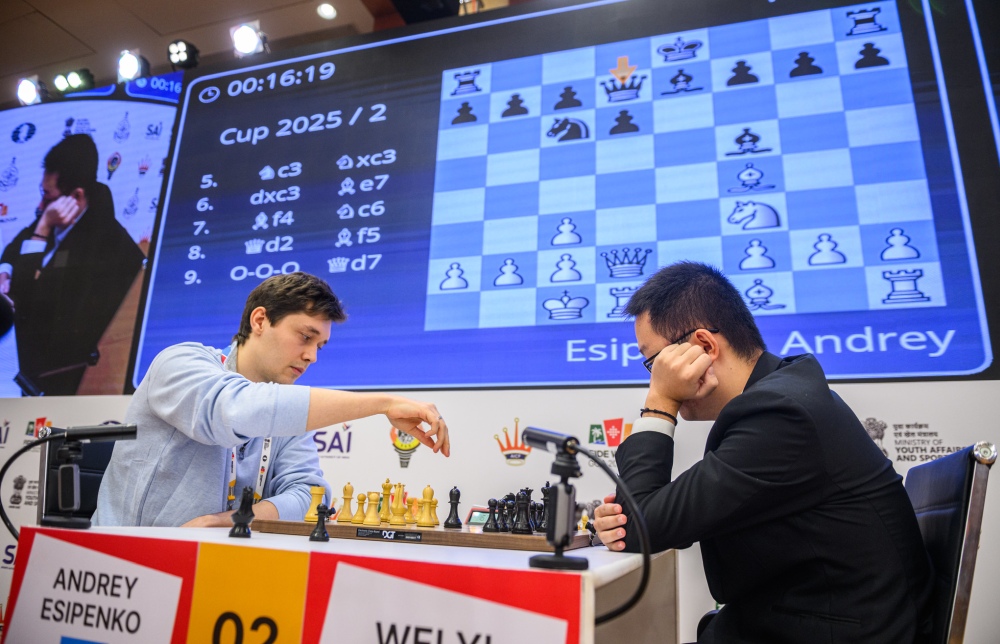
With the Black pieces, the game repeated yesterday’s Petroff Defense with the lesser-played 7.Be4, but this time Wei Yi had improved preparation and adopted a slightly different move order, confidently emerging with a better position. In the final stage of the game, a crucial moment appeared:
Both players were low on time, and this last move by White was inaccurate. Black had the strong 33…Bd6, forcing the bishops off the board due to the threat of …c5, leading to a centralised king after 34.Bxd6 Kxd6 and real winning chances. Instead, Wei opted for 33…Bf4, and after 34.Re2 Be5, the players repeated moves and drew the game.
A steady Italian Game started their second rapid encounter. For a long time, the position seemed dry, with no clear attacking prospects and a stable 0.0 evaluation. Then White misplayed, handing Wei Yi an advantage. The tension rose dramatically as both players leaned forward, calculating with everything at stake. By move 50, Esipenko had real winning chances.
King activity is a central theme in endgames, and here Black should have continued with 50…Kc5! 51.Rxh6 Kc4. Instead, he played 50…Ra2+?, keeping a material edge but reducing his winning prospects.
The game continued: 51.Kd3 Rxh2 52.Ng4 Rg2 53.Nxh6 Rxg3 54.Nf5 Rg2 55.Rh7??
This allowed Black to bring the rook across to the queenside to a strong attacking position – 55…Ra2!, followed by 56.Ke3 Ra3+ 57.Kf2 Nd2!, picking up the e4-pawn, but Esipenko let his advantage slip again with 55…Kb6? With one second remaining on his clock, Wei Yi played 56.Ne3, threatening Nd5 to win another pawn. In the resulting time scramble, Esipenko appears to have focused on defending the knight jump and overlooked his rook on g2.
After 56…c6?? 57.Nxg2 he immediately resigned. Wei Yi once again acknowledged his good fortune in the post-game interview, attributing the blunder to the natural fatigue that accumulates over such a long event.
It was a heartbreaking result for the young Esipenko, who has played an excellent tournament. Though his path to the title ends here, he still has a major goal ahead; qualifying for the Candidates by securing third place.

With the semifinal tiebreaks decided, the FIDE World Cup enters its final stretch. Javokhir Sindarov and Wei Yi now advance to the championship match, while Nodirbek Yakubboev and Andrey Esipenko prepare for the crucial third-place encounter that will determine the final 2026 Candidates qualification spot. After weeks of preparation, pressure, and emotional swings, the players return tomorrow with everything still to fight for.
The action can be followed live on the FIDE YouTube Channel, featuring expert commentary by GMs Jan Gustafsson and Peter Leko.
To watch the games in person, tickets can be purchased [HERE]
Written by WIM Charlize van Zyl (Goa, India)
Photos: Michal Walusza



